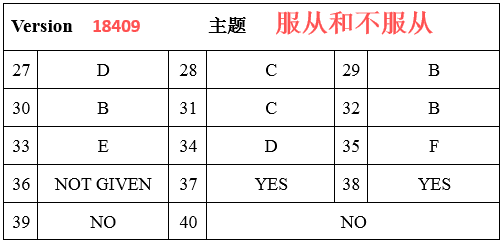托福阅读备考中,学会寻找定位词非常重要。今天小编给大家带来了托福阅读速度提升方法 ,希望能够帮助到大家,下面小编就和大家分享,来欣赏一下吧。
托福阅读速度提升方法:学会找定位词!
一.什么是托福阅读定位词?
其实很简单,打个比方,你和朋友约好了去酒吧,朋友和你说酒吧在沈阳新东方正对面,这个酒吧你是不知道地点的,也就是你的目的地;而新东方却很熟知,那么你只需找到新东方便可以找到酒吧了。在这里新东方是已知的,就是用来定位的词汇,而酒吧则是你的目的所在,也便是你要找的答案。
定位词的称呼有很多,如关键词,主旨词,功能词,中心词等等。这些只是个名称罢了,含义都是一致的:一个可以根据题干回原文定位,并能够找到出处的词,这个题干中的词就是定位词or key word。
二.定位词具体特征分析
定位词总体特征:不可变性和细节性
不可变性:定位词是用来定位的,所以必须找那些回原文依然不变的词汇,才有意义。通常不用动词和副词来定位。通常是名词或充当定语的形容词。
细节性:不要找大概念的词汇,更不要拿代表全文主旨的词汇来定位。换句话说不要找那些原文一大堆的词汇,无法定位。
如,95年英国剑桥委员会British Council给出的唯一样题文章的题目是:The Spectacular Eruption of Mount St.Helens
下面有一道选择题是“According to the text the eruption of Mount St.Helens and other volcanoes has influenced our climate by…”
拿这道题为例,如果大家把Mount St.Helens作为关键词回原文进行定位,那你会郁闷致死,全文主要讲的就是圣海伦斯火山的喷发,原文有N多个Mount St.Helens,所以即使这个词属于大写的专有名词,但他违背了细节性,是概括性的词汇,也不能作为定位词来寻找答案。
究竟哪些词在托福阅读当中充当定位词?
三.托福阅读中的定位词都有哪些类别?
1.特殊词汇
在阅读中有一些词张的比较特殊,这种词很容易被记住,也很容易回原文定位。
好比,在大街上上看到一个人光着身子跑步-------特殊难看
一个人的个子超高,像姚明一样------特殊长
一个人身上穿着10多种颜色的衣服,而且不停的摇头-----特殊怪
特殊怪,特殊长,特殊难
这三种词就是特殊词的所有特征,在文中看到这样的词,一定要警惕。如,
Sequoia美洲杉---特殊怪,很好定位,也经常作为考点。
sodium【化学】钠---特殊难,大家只要知道是一种化学元素足矣。
Simultaneous同时的---特殊长,这种词本身的特点决定应作为定位词。
2.数字:通常指时间,金钱和百分比。
有一个道题目是这样问的:
“What are the dates of the TWO major eruptions before 1980?”
那么像1980 3185$ 69%这些词因为长相原因,段落全是英文,突然跑出来几个数字,十分显眼,也就很好回原文找到他们。
3.专有名词:
斜体字,大写人名,地名,大写的专有名词,这一点大家都很熟悉,不用多说。
4.特殊符号:
在特殊符号里或者旁边的词,最好通过符号回原文进行定位,如“paper conversation”,(three cubic miles)这些词本身并没有什么特别,但放在符号里面,就可以根据符号回原文进行寻找。
托福阅读真题原题+题目
Industrialization came to the United State after 1790 as North American entrepreneurs increased productivity by reorganizing work and building factories. These innovations in manufacturing boosted output and living standards to an unprecedented extent; the average per capita wealth increased by nearly 1 percent per year — 30 percent over the course of a generation. Goods that had once been luxury items became part of everyday life.
The impressive gain in output stemmed primarily from the way in which workers made goods, since the 1790's, North American entrepreneurs — even without technological improvements — had broadened the scope of the outwork system that made manufacturing more efficient by distributing materials to a succession of workers who each performed a single step of the production process. For example, during the 1820's and 1830's the shoe industry greatly expanded the scale and extend of the outwork system. Tens of thousands of rural women, paid according to the amount they produced, fabricated the uppers of shoes, which were bound to the soles by wage-earning journeymen shoemakers in dozens of Massachusetts towns, whereas previously journeymen would have made the entire shoe. This system of production made the employer a powerful shoe boss and eroded workers' control over the pace and conditions of labor. However, it also dramatically increased the output of shoes while cutting their price.
For tasks that were not suited to the outwork system, entrepreneurs created an even more important new organization, the modem factory, which used power-driven machines and assembly-line techniques to turn out large quantities of well-made goods. As early as 1782 the prolific Delaware inventor Oliver Evans had built a highly automated, laborsaving flour mill driven by water power. His machinery lifted the grain to the top of the mill, cleaned it as it fell into containers known as hoppers, ground the grain into flour, and then conveyed the flour back to the top of the mill to allow it to cool as it descended into barrels. Subsequently, manufacturers made use of new improved stationary steam engines to power their mills. This new technology enabled them to build factories in the nation's largest cities, taking advantage of urban concentrations of inexpensive labor, good transportation networks, and eager customers.
1. What is the passage mainly about?
(A) The difficulties of industrialization in North America
(B) The influence of changes in manufacturing on the growth of urban centers
(C) The rapid speed of industrialization in North America
(D) Improved ways of organizing the manufacturing of goods
2. The word boosted in line 3 is closest in meaning to
(A) ensured
(B) raised
(C) arranged
(D) discouraged
3. The word scope in line 9 is closest in meaning to
(A) value
(B) popularity
(C) extent
(D) diversity
4. The author mentions the shoe industry in the second paragraph to provide an example of how
(A) entrepreneurs increased output by using an extended outwork system
(B) entrepreneurs used technological improvements to increase output
(C) rural workers responded to shoe bosses
(D) changes in the outwork system improved the quality of shoes
5. All of the following are mentioned as effects of changes in the shoe industry during the 1820's
and 1830's EXCEPT
(A) an increase in the worker's dependence on entrepreneurs
(B) an increase in the wages paid to journeymen shoemakers
(C) a decline in the workers ability to control the speed of production
(D) a decrease in the price of shoes
6. All of the following are true of the outwork system EXCEPT
(A) It involved stages of production.
(B) It was more efficient than the systems used before 1790.
(C) It made many employers less powerful than they had been before.
(D) It did not necessarily involve any technological improvements.
7. The word prolific in line 23 is closest in meaning to
(A) efficient
(B) productive
(C) self-employed
(D) progressive
8. According to the passage , how did later mills differ from the mills differ from the mill built by
Oliver Evans?
(A) They were located away from large cities.
(B) They used new technology to produce power.
(C) They did not allow flour to cool before it was placed in Barrels.
(D) They combined technology with the outwork system.
9. The word it in line 25 refers to
(A) water power
(B) machinery
(C) grain
(D) mill
10. The passage mentions which of the following as a result of improvements in factory
machinery?
(A) It become easier for factory' owners to find workers and customers.
(B) Manufacturers had to employ more highly skilled workers.
(C) The amount of power required for factories operate was reduced.
(D) Factories could operate more than one engine at a time.
11. The word eager in line 30 is closest in meaning to
(A) wealthy
(B) knowledgeable
(C) regular
(D) enthusiastic
PASSAGE 94 DBCAB CBBCA D
2020托福阅读速度提升方法相关文章:
★ 二战托福攻略
2020托福阅读速度提升方法
上一篇:托福阅读出题特点及练习方法
下一篇:返回列表





